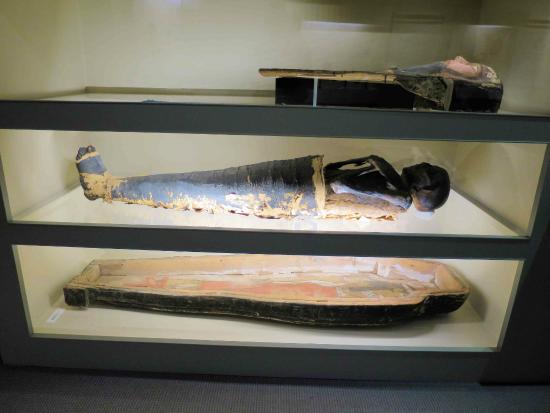The Albany Mummie

Whether your familiarity with these symbolic tombs come from the movies, a toilet-paper-wrapped Halloween costume, or from a general knowledge of mummification and the sacrality behind it, it’s safe to assume that most of us associate mummies with preserved persons with Ancient Egypt. Therefore, how is it that two mummies are lurking continents away from home here in Albany, New York?
The Albany Institute of History and Art has been open since 1791, accepting its place as the second oldest museum in the country just behind the Charleston museum founded in 1773. The institute provides vast arrays of fascinating exhibits, including the Hudson River Valley School and Traders and Culture displays. However, arguably the most interesting exhibit within the museum is that of Ancient Egypt, what with countless terrific artifacts, notably those of the twenty-first century mummy, Ankhefenmut, and the Ptolemaic mummy who remains unnamed. Both of these ancient men are some of the most popular attractions in the Albany Institute and are displayed within glass viewing cases so many can celebrate their rich histories and culture. However, how is it that we have these mummies in Albany?
In 1909, a man by the name of Samuel W. Brown, with his wife Rosa, ventured on what would become his second expedition to Cairo, Egypt, and one of the most significant voyages Brown would ever take. Samuel Winfield Brown was an avid traveler and vital community member in Albany as he was actively involved in several organizations including St. Peters Episcopal Church, the Albany Memorial Hospital, the Albany Association of the Blind, and most significantly the Albany Institute of History and Art, in which he was good friends with Cuyler Reynolds, the museum director from 1899-1909. While in Cairo, Brown received many letters from Reynolds encouraging him to acquire Egyptian curios for the Albany Institute.
As fate would have it, Brown could not have chosen a more fortunate time to travel. In 1909, a cache, or collection, was discovered at Deir-el-Bahri, later renamed Bab-el-Gasus, translating to “Gate of Priests,” an archeological site at Thebes, a city in upper Egypt. Sold at the time by the Egyptian Museum in Cairo to educational institutions, Brown purchased the two mummies and their coffin bases for the Albany Institute. During his purchase, Brown instructed the assistant director of the Egyptian museum to uncover the Ptolemaic mummy partly to see what condition he was in. One of the employees slashed the cloth around the mummy’s head with a sharp knife until he reached the skull and Brown was delighted to find that it proved to be hard, indicating the mummy was preserved well and therefore had strength remnant within his bones.
If you visit this mummy today, he is still uncovered from head to waist, allowing the viewer a peak at the composed skeleton of a preserved human. Through his purchase, Brown was told he was receiving a man and woman or “priest and priestess,” as they were titled by the museum. However, on March 31st, 2012, as the mummies were sent to Albany Medical Center to be CT scanned and x-rayed, Ankhefenmut was discovered to be a male between fifty and fifty-five years of age. Therefore, both mummies are recognized as men within today’s tours and information catalogs. Regardless, a long journey awaited these mummies as they were transferred in the steamship Oceana on March 11th, 1909 to arrive on April 22nd in New York City and transported to Albany aboard the People’s Line, a transportation vessel, shortly after. With this transaction, the mummies were at last in Albany, New York.
You can visit the mummies today in the Albany Institute of History and Art, as although the museum changed its mission to concentrate on regional heritage with a focus on the Hudson River Valley exhibit in 1926, the beloved Albany mummies remain untouched within the Ancient Egypt exhibit on the third floor of the institution. There is much more to learn about these two fascinating specimens and the eras in which they lived. Over a hundred years after Samuel W. Brown gained these mummies, they are still visited frequently today and are acknowledged for their awe-invoking appearances and extraordinary histories.

